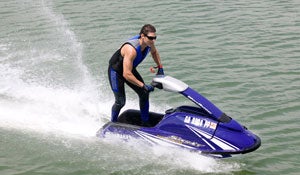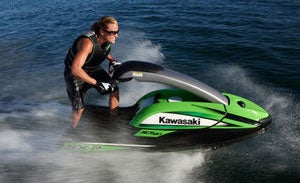How to Ride a Stand-up PWC
It's never too late to learn
I’ve mentioned that this is likely the last year to buy a production stand-up, like the Kawasaki Jet Ski 800 SX-R or Yamaha SuperJet. That’s sad news, but it doesn’t mean the end of the craft as we know it. Plenty of used models will still be on the market, and many of them will likely be going for some pretty attractive deals.
Think it’s time you found out what you’ve been missing? Here’s a primer on how to ride a stand-up PWC…in just a few easy steps.
Like Learning to Ride a…
 Learnign to ride a stand-up is all about balance – much like riding a bike.
Learnign to ride a stand-up is all about balance – much like riding a bike.I’ve heard the process of learning to ride a stand-up compared to learning how to ride a bike as a child, and in many ways that’s true. It’s all about balance, after all, but it’s also all about power. Go slow on a bike and you’ll wobble. Speed up and you’ll find more control and stability. A stand-up PWC shares that same trait. So first suggestion, don’t be afraid of the power. Used wisely, and within reason, it can actually stabilize the craft as well as help pull you through turns.
I’ve also heard learning to ride a stand-up compared to slalom water skiing, even skateboarding. Why? Both require you to put one foot forward. A staggered stance provides more stability, and will improve your turning ability in the long run. To find your stance, look to similar sports you already do for a hint. Or try this: stand with your feet together, and have a friend give you a push from behind. Typically you’ll favor one foot to move forward and catch yourself.
That stance doesn’t have to remain the same. While some riders stick with one foot forward at all times, others prefer to switch which foot is forward depending on the direction of the turn, i.e. left foot forward for left turns and right foot forward for right turns.
On Your Knees
 Speed is your friend. Go too slowly and you’ll wobble.
Speed is your friend. Go too slowly and you’ll wobble.Ready to ride? Start in chest-deep water, lying on your stomach in the tray area of the craft. Your feet will be extended behind you, off the craft, while your elbows should be resting on the craft’s gunwales. Start the boat and begin to slowly accelerate, until the point the boat feels stable. Avoid staying in this position too long, or at too fast a speed. It’s not comfortable, and the craft will often start to porpoise.
Once you feel stable, keep a steady pressure on the throttle and bring one leg at a time forward, so that you’re kneeling in the tray. Don’t let off the throttle; as you raise your center of gravity, you’ll likely feel wobblier atop the craft. A steady speed is your friend. If you start to porpoise uncomfortably, move forward to shift more weight toward the bow.
Rise…
.jpg) Once you get comfortable and find your balance you can start practicing turns and the real fun begins.
Once you get comfortable and find your balance you can start practicing turns and the real fun begins.Time to get off your knees. You’ve already decided which foot to place forward. Bring that foot up and plant it firmly forward in the tray, transferring your weight to that leg and raising yourself into a standing position, lifting the handlepole as you rise. Your trailing foot should come in behind, but stay to the opposite side of the tray, and more toward the back of the craft. Stay centered; tilting one direction or the other at this point will quickly put you back in the water.
Hopefully, you’re up. Stay that way by remaining in a slight crouch, knees bent to absorb shock and lower your center of gravity, arms relaxed holding the handlepole.
Take some time to get used to the feeling and your balance before attempting any turns. When you feel comfortable, turn in one direction by using a combination of handlebar input and body english. Don’t lean too far at this point, as you’ll likely fall. Just start with gentle turns in both directions. As you become more confident, increase your speed as well as the amount you lean to sharpen the turning radius.
And that’s all there is to it. Sure, there’s a learning curve, but that’s what makes it fun. And once you’ve mastered the basics, nothing else quite compares.
Related Reading
Stand-Up PWC May Be Reaching the End of an Era
2011 Yamaha SuperJet Review
2011 Kawasaki Jet Ski 800 SX-R Review
The Life of Mark Gomez
Get PersonalWatercraft.com in your Inbox!
Like PersonalWatercraft.com on Facebook
Comments
Most Popular

2025 Yamaha JetBlaster PRO 2-Up Review

2024 Kawasaki Jet Ski STX 160X Review

Remembering the Sea-Doo XP

Whatever Happened to the Wetbike?

2025 Yamaha JetBlaster Review













 Your Privacy Choices
Your Privacy Choices